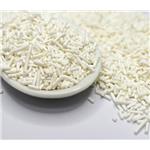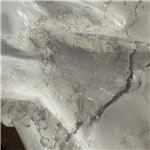- Potassium sorbate
-

- $9.00 / 1KG
-
2024-04-16
- CAS:590-00-1
- Min. Order: 500KG
- Purity: 99%
- Supply Ability: 10tons
- Potassium Sorbate
-

- $0.00 / 1kg
-
2024-03-25
- CAS:590-00-1
- Min. Order: 1kg
- Purity: 99
- Supply Ability: 20tons
- Potassium sorbate
-

- $45.00/ kg
-
2024-03-19
- CAS:590-00-1
- Min. Order: 1kg
- Purity: 99.8%
- Supply Ability: 200tons/year
|
| | Potassium sorbate Chemical Properties |
| | Potassium sorbate Usage And Synthesis |
| Chemical properties | It appears as white to pale yellow flaky crystals and crystalline powder or granular. It is odorless or slightly smelly. Long-term storage in the air is easy to absorb moisture and oxidative decomposition as well as coloring. Relative density (d2025): 1.363. The melting point temperature: 270 ° C (decomposition). It is easily soluble in water (67.6g/100ml, 20 ℃) 5% salt water (47.5g/100ml, room temperature), 25% sugar water (5lg/100ml, room temperature). It can be dissolved in propylene glycol (5.8 g/100 ml), ethanol (0.3 g/100 ml) with the pH value of the 1% aqueous solution being 7 to 8.
It has a strong effect on inhibiting spoilage and mold, and because of its lower toxicity than other preservatives, it has become the world's most important preservatives.
In acidic conditions, it can give full effect of anti-corrosion while the effect is the lowest in neutral condition.
| | Uses |
- Potassium sorbate is a chemical food preservative. Its anti-microbial properties stop the growth and spread of harmful bacteria. When used correctly, it inhibits bacterial growth in colostrum and milk. It can also be used to preserve antibody levels in ‘gold’ (first milking) colostrum.
- Potassium sorbate is use as an antimicrobial preservative prevents the growth of mold, bacteria and fungi in cheese, dried meats, baked goods, jellies and syrups. As a preservative in dried fruit, potassium sorbate often replaces sulfur dioxide, which has an aftertaste. The addition of potassium sorbate to dietary supplements inhibits microbes and increases shelf life. Many personal care products use potassium sorbate to prolong shelf stability and prevent bacteria contamination. Acting as a wine stabilizer, potassium sorbate prevents yeast from fermentation past the wine’s bottling stage. By inhibiting the fermentation process, it ceases production of yeast.
- Potassium sorbate is not a broad spectrum preservative for cosmetic use and should be combined with other preservatives. If potassium sorbate is used as a preservative, the pH of the finished product may need to be reduced for potassium sorbate to be effective. This is because potassium sorbate is the inactive salt form of sorbic acid. To be useful, the pH of the formulation must be low enough to release the free acid for useful activity.
- Potassium sorbate is a food grade preservative generally regarded as safe (GRAS) worldwide. It is the inactive salt of sorbic acid. It readily dissolves in water where it converts to sorbic acid, its active form, at a low pH. Sorbic acid is very pH dependent. While it shows some activity up to pH 6 (about 6%), it is most active at pH 4.4 (70%). At pH 5.0 it is 37% active. As sorbic acid, it is considered to be active against mold, fair against yeast and poor against most bacteria. Sorbic acid is an unsaturated fatty acid and as such is subject to oxidation (use of an antioxidant like Mixed Tocopherols T50 is recommended). It is also sensitive to UV light and may turn yellow in solution. Gluconolactone is reported to stabilize potassium sorbate against discoloration and darkening in aqueous solutions and may be useful in stabilizing sorbic acid in the water phase of a product.
| | Toxicity | ADI 0 to 25 mg/kg (based on sorbic acid, including sorbic acid and its salts; FAO/WHO, 2001).
LD50: 4920 mg/kg (rat, oral);
GRAS (FDA, § 182.3640, 2000); | | Content analysis | Take 0.25g (accurate to 0.1mg) sample pre-dried at 105 ℃ for 3h and put into a 250 ml flask equipped with a glass stopper. Add 36 mL acetic acid and 4 mL acetic anhydride, heat and warm into a solution. When cooled to room temperature, add 2 drops of crystal violet test solution (TS-74) and titrate with the acetate solution of the 0.1mol/L perchloric acid to blue-green end point which maintains 30 s without disappearing. At the same time, perform a blank test and make the necessary correction. Each mL of 0.1mol/L perchloric acid is equivalent to 15.02 mg of potassium sorbate (C6H7KO2).
| | Usage limit | GB 2760-2002 (g/kg): the same as "07023, sorbic acid" (based on sorbic acid); Chewing gum base GMP; pre-tune wine 0.2; meat enema 1.5. Sorbic acid per gram is equivalent to 1.33 g potassium sorbate.
FAO/WHO(1984,mg/kg):Dried apricot (based on sorbic acid); pickled cucumber 1000; man-made cream, jam and jelly 1000; vegetable olives, orange peel jelly 500 (based on sorbic acid), processed cheese 3000; pineapple juice with preservative 1000.
Limited amount in Japan, 1997 (based on sorbic acid, g/kg): stuffing, bakery products, jams and fruit juice (including concentrated fruit juice), (wine) pickled with grains products, salted product, Sauce stained product, fermented soybean cured product, cherries can, dried fish and shellfish products (excluding squid, octopus products), jam, syrup, Japanese radish pickles, Japanese braised, boiled beans, Japanese fermented soybean, 1.0; margarine 1.0 (the combination amount is 1.0 when used in combination with benzoic acid and its salt); Seasoning ketchup, dipping sauce, soup (excluding soup), seasoning, ginger soup, dried prune , 0.50; sweet wine (limited to being diluted to over 3 fold), Lactic acid bacteria beverage produced by fermented milk and lactobacillus base stock, 0.3; Fruit wine, mixed wine, 0.20; lactic acid bacteria drinks (excluding people drink after sterilization) 0.05. Cheese 3.0 (when combined with propionate and propionate salt, the combined amount of ≤ 3.0). Fish meat, whale meat, meat products, 2.0; Smoked cuttlefish, smoked octopus, 1.5.
The application standard for the part in United States (%): beverages 0.003 to 0.03; bread, pastry 0.004 to 0.1; chocolate pulp 0.05 to 0.2; carbonated beverages syrup 0.05 to 0.1; fresh fruit cocktail 0.05 to 0.1; citrus pulp (sherbet and fruit juice ice cream base) 0.05 to 0.1; cheese cake 0.05 to 0.1; salad pudding 0.05 to 0.1; stuffing material 0.05 to 0.1; cake 0.1; small package cheese: 0.1 or less; synthetic sweetener jelly: 0.1 or less.
EEC (1990); yoghurt, margarine, cheese, salad, pudding, cakes, canned fruit, frozen pizza, pickled cucumber, apricots and so on, not limited (GMP); grape wine: 200 mg/mL | | Standard for Maximum Allowable Amount |
Name of additive
Food allowed to use
Additive function
Maximal allowable usage amount (g/kg)
Potassium Sorbate
Other cereal products (cereals only enema products)
preservative
1.5
otassium Sorbate
Instant rice noodle products (only rice noodles enema products)
preservative
1.5
Potassium Sorbate
Gum base candy
Base material in the gum base candy
appropriate amount according to requirement except in case where specific amount is documented
Potassium Sorbate
Tea, coffee, vegetable drinks class
preservative
0.5
Potassium Sorbate
Instant rice noodle products (only rice noodles enema products)
preservative
1.5
Potassium Sorbate
Margarine
preservative
1
| | Preparation | It can be derived through neutralization of sorbic acid by potassium carbonate or potassium hydroxide. | | Toxic classification poisoning | Acute Toxicity Oral-Rat LD50: 4340 mg/kg; Oral-mouse LD50: 3800 mg/kg
Flammable and hazardous properties Flammable with combustion releasing potassium oxide spicy and irritant smoke | | Storage and transport characteristics | Treasury: low temperature, ventilated and dry | | Fire extinguishing agent | water, carbon dioxide, dry powder, sand | | Chemical Properties | White powder. Soluble in water (25C). | | Chemical Properties | Potassium sorbate was first discovered by the French in the 1850s, having been derived from the mountain ash tree. It
is widely used in the food industry and few substances have had the kind of extensive, rigorous, long-term testing that sorbic acid and
its salts have had. It decomposes at about 270°C. For a detailed description of this compound, refer to Burdock (1997). | | Occurrence | Reported found in blueberries. | | Uses | potassium sorbate is a preservative primarily against mold and yeast, and used in concentrations of 0.025 to 0.2 percent. It is non-toxic but may cause mild skin irritation. | | Uses | Pharmaceutic aid (antimicrobial
agent). | | Uses | Potassium Sorbate is a preservative that is the potassium salt of sor-
bic acid. it is a white crystalline powder which is very soluble in
water, with a solubility of 139 g in 100 ml at 20°c. this solubility
allows for solutions of high concentration which can be used for
dipping and spraying. it is effective up to ph 6.5. it has approxi-
mately 74% of the activity of sorbic acid, therefore requiring higher
concentrations to obtain comparable results as sorbic acid. it is effec-
tive against yeasts and molds and is used in cheese, bread, beverages,
margarine, and dry sausage. typical usage levels are 0.025–0.10%. | | Uses | Potassium sorbate, the potassium salt of sorbic acid, is a naturally-occurring organic acid. Potassium sorbate is the most widely used food grade preservative and is not a broad spectrum preservative for cosmetic use. It is used as a mold, bacterial and yeast inhibitor and as a fungistatic agent in foods. It is also used in cosmetics, pharmaceuticals, tobacco and flavoring products. | | Production Methods | Potassium sorbate is produced industrially by neutralizing sorbic acid with potassium hydroxide. The precursor sorbic acid is produced in a two-step process via the condensation of crotonaldehyde and ketene. | | Definition | ChEBI: Potassium sorbate is a potassium salt having sorbate as the counterion. It has a role as an antimicrobial food preservative. It contains an (E,E)-sorbate. | | Toxicology | In pure form, potassium sorbate is a skin, eye, and respiratory irritant.Concentrations up to 0.5% are not significant skin irritants.
As a food additive, potassium sorbate is used as a preservative in concentrations of 0.025–0.100%, which in a 100 g serving yields an intake of 25–100 mg. In the United States, no more than 0.1% is allowed in fruit butters, jellies, preserves, and related products.[18] Up to 0.4% has been studied in low-salt, naturally-fermented pickles, and when combined with calcium chloride, 0.2% made "good quality pickles." Potassium sorbate has about 74% of sorbic acid's anti-microbial activity. When calculated as sorbic acid, 0.3% is allowed in "cold pack cheese food." The upper pH limit for effectiveness is 6.5.
The maximal acceptable daily intake for human consumption is 25 mg/kg, or 1750 mg daily for an average adult (70 kg). Under some conditions, particularly at high concentrations or when combined with nitrites, potassium sorbate has shown genotoxic activity in vitro. | | Safety Profile | Moderately toxic by
intraperitoneal route. Mildly toxic by
ingestion. Mutation data reported. When
heated to decomposition it emits toxic
fumes of K2O. | | Synthesis | Manufactured by organic synthesis |
| | Potassium sorbate Preparation Products And Raw materials |
|